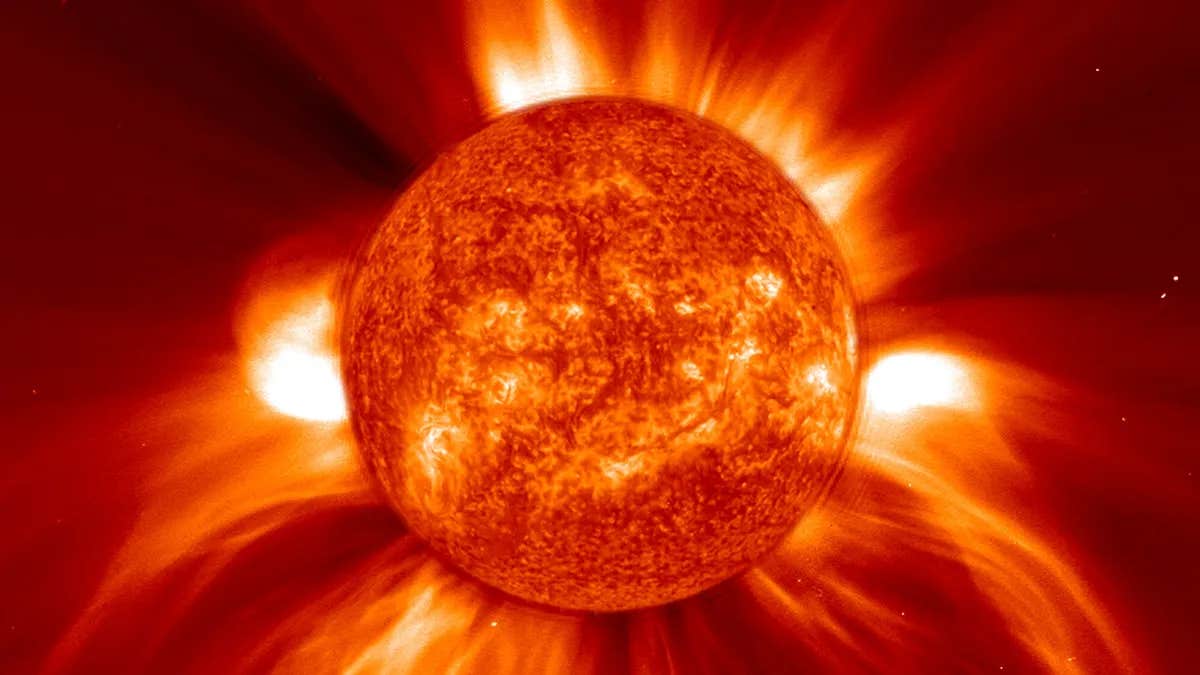Scientists finally explain why the Sun’s corona burns millions of degrees hotter than its surface
Scientists spotted twisting magnetic waves in the Sun’s corona that could explain how its outer atmosphere reaches millions of degrees.

 Edited By: Joseph Shavit
Edited By: Joseph Shavit

Twisting magnetic waves could explain why the Sun’s atmosphere is so hot. (CREDIT: ESA/NASA/Soho)
For decades, scientists have wondered how the Sun’s outer atmosphere — the corona — burns millions of degrees hotter than its surface. A new study led by Northumbria University physicist Richard Morton offers a major clue: the Sun’s heat may come from tiny magnetic waves that twist and ripple through its outer layers like an invisible dance.
Cracking the Corona’s Heat Mystery
The Sun’s visible surface, called the photosphere, sits at about 5,500 degrees Celsius. Yet the corona above it reaches temperatures exceeding a million degrees. For that to happen, something must transport and amplify energy upward — and fast. The heated plasma escaping from the corona forms the solar wind, a constant stream of charged particles that shapes space weather and interacts with planetary magnetic fields, including Earth’s.
Scientists have long suspected that waves moving along the Sun’s magnetic field lines — known as Alfvén waves, after Nobel laureate Hannes Alfvén — might carry that energy. But while large, violent versions of these waves had been observed during solar flares, the small, constant ones believed to power the Sun itself remained elusive. Until now.
A Powerful New Look at the Sun
Morton and his international team captured the first direct evidence of these small-scale “torsional Alfvén waves,” using the world’s most advanced solar telescope — the Daniel K. Inouye Solar Telescope (DKIST) in Hawaii. Equipped with its Cryogenic Near Infrared Spectropolarimeter (Cryo-NIRSP), DKIST can detect fine details in the corona that were previously impossible to see.
With a four-meter mirror — the largest ever built for solar observation — and a specialized infrared spectrometer, the telescope observed iron in the corona heated to about 1.6 million degrees Celsius. The data, collected on October 30, 2023, revealed subtle shifts in light that showed plasma twisting back and forth along magnetic flux tubes about 0.1 solar radii above the Sun’s visible edge.
Morton explained that the challenge wasn’t just spotting motion, but separating one type of wave from another. “The movement of plasma in the sun’s corona is dominated by swaying motions,” he said. “These mask the torsional motions, so I had to develop a way of removing the swaying to find the twisting.”
Watching the Sun’s Magnetic Dance
By filtering and analyzing the Doppler shifts — changes in wavelength caused by plasma moving toward or away from Earth — the researchers found the telltale red and blue pattern of twisting motion: one side of a magnetic tube moving toward us while the other moves away. This is the fingerprint of torsional Alfvén waves.
The team measured twisting speeds averaging around 19.5 kilometers per second after correcting for viewing angle and other effects. That’s about the speed of a high-altitude jet aircraft and strong enough to move significant amounts of energy through the solar atmosphere. These waves were found in quiet regions of the corona, not just in stormy flare zones, suggesting they occur constantly across the Sun.
Simulations run by the researchers supported the observations, showing that torsional motions dominate near the edges of magnetic structures while “kink” waves — the side-to-side swaying — dominate their centers. Together, these motions generate a steady flux of magnetic energy.
Enough Energy to Power the Sun’s Outer Layers
The study estimated that the energy carried by these Alfvén waves ranges from about 100 to 400 watts per square meter. That’s more than enough to heat the quiet corona and help accelerate the fast solar wind that streams through the solar system.
The data also hint that these estimates may be conservative. Because multiple magnetic tubes overlap along the line of sight and telescope resolution has limits, some of the wave energy may go undetected. Correcting for these effects could push the energy levels even higher.
Morton’s findings align with long-standing theories that Alfvén waves convert magnetic energy into heat through turbulent interactions in the plasma. “This discovery ends a protracted search for these waves that has its origins in the 1940s,” he said. “We’ve finally been able to directly observe these torsional motions twisting the magnetic field lines back and forth in the corona.”
The Global Effort Behind a Breakthrough
The research, published in Nature Astronomy, was a collaboration among scientists from Northumbria University, the National Solar Observatory in Hawaii and Colorado, Peking University, KU Leuven, Queen Mary University of London, and the Chinese Academy of Sciences.
Northumbria University’s contribution extended beyond analysis — it helped design cameras for one of DKIST’s major imaging instruments. Morton secured telescope time even before full operations began, taking advantage of a rare testing window to capture the groundbreaking data.
Illuminating Space Weather and the Solar Wind
Understanding how energy moves through the Sun’s atmosphere isn’t just about curiosity. The solar wind — the stream of charged particles flowing from the corona — influences the entire solar system. When it intensifies, it can disrupt satellites, interfere with GPS, and even overload power grids on Earth.
Alfvén waves may also explain “magnetic switchbacks,” sudden reversals in solar wind direction that have been recorded by NASA’s Parker Solar Probe. If these twisting motions help drive such phenomena, they could become key to forecasting space weather events more accurately.
This work represents the first step toward decoding how energy flows and dissipates in the corona. The team plans to follow the waves farther out from the Sun to see how they evolve and where they release their energy as heat. Future studies combining DKIST’s data with images from spacecraft like the Parker Solar Probe could reveal the full life cycle of these magnetic waves.
As Morton puts it, having direct observations “finally allows us to test these models against reality.” For the first time, solar physicists can match their equations and computer models to what’s really happening on the Sun’s surface.
Practical Implications of the Research
The discovery of small-scale torsional Alfvén waves reshapes how scientists understand the Sun’s energy system. It provides a credible explanation for why the corona burns millions of degrees hotter than the surface and how the solar wind is accelerated.
On a practical level, these insights can improve forecasts of solar storms that threaten satellites, astronauts, and electrical grids on Earth.
The ability to trace how magnetic energy moves through the Sun’s atmosphere also strengthens our understanding of magnetic turbulence — a process that influences plasmas across the universe, from stars to fusion reactors.
Research findings are available online in the journal Nature Astronomy.
Related Stories
- New telescope technology reveals Sun’s corona in unmatched detail
- Astronomers solve the mystery of why the Sun’s outer atmosphere is far hotter than its surface
- New X-ray scans track violent solar winds threatening Earth’s satellites
Like these kind of feel good stories? Get The Brighter Side of News' newsletter.
Joshua Shavit
Science & Technology Writer and Editor
Joshua Shavit is a Los Angeles-based science and technology writer with a passion for exploring the breakthroughs shaping the future. As a co-founder of The Brighter Side of News, he focuses on positive and transformative advancements in AI, technology, physics, engineering, robotics and space science. Joshua is currently working towards a Bachelor of Science in Business and Industrial Engineering at the University of California, Berkeley. He combines his academic background with a talent for storytelling, making complex scientific discoveries engaging and accessible. His work highlights the innovators behind the ideas, bringing readers closer to the people driving progress.



